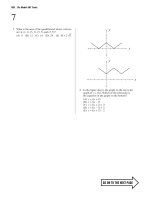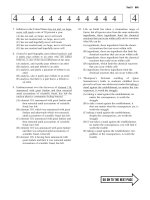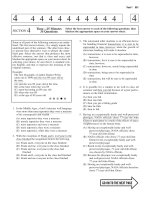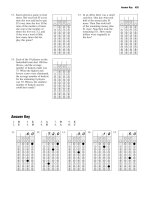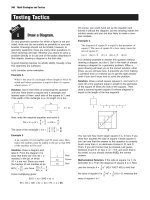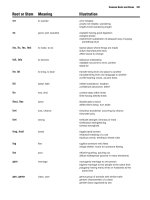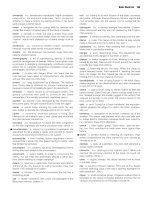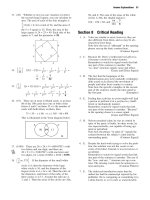McGraw hills SAT 2014 edition black, christopher anestis, mark
Bạn đang xem bản rút gọn của tài liệu. Xem và tải ngay bản đầy đủ của tài liệu tại đây (33.01 MB, 1,285 trang )
Welcome to
McGraw-Hill’s
SAT
Congratulations! You’ve chosen the SAT guide from America’s leading educational publisher. You
probably know us from many of the textbooks you used in school. Now we’re ready to help you take
the next step — and get into the college or university of your choice.
This book gives you everything you need to succeed on the test. You’ll get in-depth instruction and
review of every topic tested, tips and strategies for every question type, and plenty of practice exams
to boost your test-taking confidence. To get started, go to the following pages where you’ll find:
How to Use This Book: Step-by-step instructions to help you get the most out of your test-prep
program.
Your SAT Action Plan: Learn how to make the best use of your preparation time.
SAT Format Table: This handy chart shows the test structure at a glance: question types, time
limits, and number of questions per section.
The 50 Top Strategies for Test Day: Use this list to check your knowledge, or as a last-minute
refresher before the exam.
The 9 Core SAT Essay Themes: Find out the most common SAT essay themes, based on the SATs
from the past 5 years.
The 5 Top SAT Calculator Tips: Learn some smart ways that your calculator can help you.
Getting the Most from the Free Online Practice Tests and Problem-Solving Videos: Log on to
the companion website for more test-taking practice and to view videos demonstrating the use of
problem-solving strategies to answer SAT questions.
ABOUT McGRAW-HILL EDUCATION
This book has been created by McGraw-Hill Education. McGraw-Hill Education is a leading
global provider of instructional, assessment, and reference materials in both print and digital
form. McGraw-Hill Education has offices in 33 countries and publishes in more than 65
languages. With a broad range of products and services — from traditional textbooks to the
latest in online and multimedia learning — we engage, stimulate, and empower students and
professionals of all ages, helping them meet the increasing challenges of the 21st century
knowledge economy.
How to Use This Book
This book is designed for students who want an effective program for the most dramatic SAT score
improvements. It is based on the College Hill Method™, the elite training system used by the tutors
of College Hill Coaching since 1990. It focuses on what works best in SAT prep: mindful training
in the reasoning skills at the core of the SAT, and not just test-taking tricks or mindless drills.
This book provides all the material you need to score well on the SAT. It will teach you the
knowledge that is required for this difficult exam, including information about each type of question
on the test. It also provides ample practice for you to refine the skills you are learning and then test
yourself with full-length practice tests. For best results as you work your way through the book and
the accompanying online tests, follow this four-step program:
1 Learn About the SAT
Don’t skip Chapter 1. In it you’ll meet the SAT and learn exactly what academic skills it tests.
You’ll also find valuable test-taking strategies and information about how the test is scored.
2 Take a Realistic Practice SAT
Take the SAT diagnostic test in Chapter 2 of this book. Take the test strictly timed, in one sitting,
and proctored if possible. Then use the answer key to evaluate your results so you can learn your
strengths and weaknesses. Fill out the “College Hill SAT Study Plan” at the end of the test to
analyze the strategies, concepts, reasoning skills, and vocabulary that you need to learn.
3 Study What You Need to Learn with the Lessons, Exercises, and Videos
If you miss a question on your practice SAT, read its answer explanation at the end of the test. If it
refers to a lesson in chapters 4–15, make that lesson part of your weekly review.
First read each Lesson carefully, underlining important ideas or writing notes in the margins.
Then move on to the Concept Review worksheet, which reinforces the key ideas in the lesson.
Try to answer these questions without peeking back at the lesson. Circle any tough questions as
you go so that you can review them later. Check your answers with the Answer Key.
Then move on to the SAT Practice worksheet, which gives you questions as they might appear
on the SAT. Work through these questions as if you were taking a real SAT.
When you’re done, read all of the explanations in the Answer Key, even for questions that you
got right. Why? Because very often, there are many ways to get a question right, and some may
be much more efficient than the one you used!
To learn more about how to use SAT problem-solving strategies, view the videos on the
companion website at MHPracticePlus.com.
4 Repeat the Cycle Until You’ve Surpassed Your SAT Score Goal
Take the practice tests at the back of this book and on the companion website, trying each time to
simulate actual testing conditions. After you take each test, fill out the College Hill SAT Study Plan
at the end of the test to help you analyze your results. If you are still having problems, go back and
review the corresponding lessons in chapters 4–15.
Your SAT Action Plan
To make the best use of your SAT preparation time, you’ll need a personalized action plan that’s
based on your needs and the time you have available. This book has been designed for flexibility; you
can work through it from cover to cover or you can move around from one chapter to another in the
order you want based on your own priorities and needs. However, before you jump in, maximize the
effectiveness of your preparation time by spending a few minutes to develop a realistic action plan.
Use the tools provided in these pages to help you focus on the areas where you are weakest, plan your
study program, and gain the discipline you need to pace yourself and achieve your goals.
The College Hill SAT Study Plan
Each time you take a practice SAT in this book, on the CD (if you have purchased the book-CD
version) or online, take a few minutes to fill out the College Hill Study Plan once you are finished. A
copy of the plan is shown on page 4A. Blank Plans appear at the end of each test; for the CD or online
tests, make your own copy of the plan. The Plan shows you your progress and provides an action plan
for improving your score over the next week. Here’s how to fill it in:
Scores
Write your raw and scaled scores in the box at the top, following the directions in the Score
Conversion Table at the end of each test. These provide a record of your weekly progress.
Questions About the Test
1 What were your test conditions? Did you take your practice SAT as you would take a real
SAT? Were you sitting at a desk and at a neutral site? Did you time yourself strictly? Did you take
the test all at one sitting? If your conditions were not realistic, make sure that they are more
realistic next time. Also, note any conditions that may have affected your performance, like
“broken clock,” “noisy radiator,” “freezing room,” or “phone interruption.” Learning to deal with
distrac -tions and with the length and time limits of the SAT is very important to peak
performance.
2 What was your pre-test routine? What you do just before the test can be very important to your
performance. Having a raging argument with someone, for instance, probably won’t help. To
perform your best, get at least 8 hours of sleep the night before, get 30 minutes of exercise prior to
the SAT, and have a good breakfast. Write down anything significant that you did just prior to the
test, like “ran 4 miles,” “had oatmeal and orange juice,” “was yelled at by Dad,” or “did 15
minutes of yoga.”
3 Did you attack the questions you need to attack? The table on the upper right of the worksheet
shows you what percent of questions you should plan to attack, and what percent you should get
right, in order to achieve particular score goals. Set an aggressive but realistic score goal for
yourself on each section: Critical Reading, Math, and Writing. Then, after taking the test, notice
how close you came to the percentages you need on each section. The “attack” percentage is the
total number of questions you answered (right or wrong) divided by the total number of questions
on that section. (There are 67 total Critical Reading questions, 54 total Math questions, and 49
total Writing questions.) The “get” percentage is the total number of raw score points you got on
each section divided by the total number of questions on that section. For instance, if you’re
gunning for a 600 math score, you’ll have to get 67%, or about two-thirds, of the available points
on that section. Of course, you should attack more than 67% of the questions to give yourself room
for error, but don’t answer too many questions so that you rush and make a lot of careless
mistakes. A good compromise is to attack about 85% of the questions and leave the hardest 15%
(about 3 of every 20) unanswered, hoping to get 67% of the available points.
College Hill™ SAT Study Plan
Be sure to attack the easy questions first. On every subsection except the Critical Reading
passages, the questions start easy and get harder. If your plan involves skipping questions, make sure
they are the hard ones at the end, not the easy ones at the beginning. However, don’t get bogged down
on any question, even one that is supposed to be “easy.” Your job is to maximize your points, so if a
question seems challenging at first, move on and come back to it later if you have time.
4 Did you rush to complete any section? Although it’s always better to skip tough SAT questions
rather than get bogged down by them, it’s also never good to rush. After you complete a practice
SAT, ask yourself: did I make any careless errors because I was rushing? Remember: because of
the SAT’s wrong-answer penalty, skipping a question is better than getting it wrong!
5 How many more raw points do you need to make your score goal? Again, the table at the top
right of the worksheet provides your guide. Just look up your score goal for each section and find
the corresponding raw score needed for that goal, and then subtract your actual raw score for
each section. This tells you how many more questions you’ll need to pick up.
6 Did you make educated guesses on any questions? While some students are very reluctant to
leave any question unanswered, others have the opposite feeling and think that they should never
guess on a question unless they are absolutely certain. But this is a bad strategy too. Educated
guessing usually helps your score; if you can eliminate just a couple of wrong answers, take your
best guess. When reviewing your test, look at the questions you guessed on, and notice whether
you picked up points from them.
7 Study Plan. This is the real key to improving your SAT score. Go to the answer explanations and
carefully read the explanations for the questions you missed. Then notice the lesson(s) listed after
each explanation, and list these lessons on this part of the Study Plan. If you need to improve your
reading skills, include “Chapter 4, Critical Reading Skills.” If you need to work on sentence
completion strategies, include “Chapter 5, Sentence Completion Skills. If the multiple-choice
questions on the Writing section are giving you trouble, include “Chapter 14, How to Attack SAT
Writing Questions.” If you are struggling with the essay, then include “Chapter 12, Writing a Great
Essay” or “Chapter 13, Essay Writing Practice.” Next, from the sentence completion explanations,
list the vocabulary words that gave you trouble and make flashcards (using the method described
in Chapter 3) to study in the coming weeks.
College Hill™ SAT Weekly Study Schedule
Your Weekly SAT Study Schedule
Once you have a plan, it’s time to start studying. Be diligent, but don’t overwhelm yourself. Your
schoolwork should take priority over SAT prep — colleges care a lot about those grades, and for
good reason! But if you make a manageable plan to work for at least 30 minutes every weeknight on
your SAT review, you will see great results in just a matter of weeks.
Page 6A shows a suggested Weekly SAT Study Schedule. Most students find this schedule both
manageable and highly productive. Of course, you will need to adapt it to your own schedule, but
remember that it is more productive to do some work every day rather than a lot of work just one day
a week.
Notice that this study schedule (which, remember, is only a basic guide) includes two “ground work” weeks, in which you will work through lessons in those areas that almost every student needs
to review: vocabulary skills, reading skills, and persuasive writing skills. As such, the first two
weeks of the schedule don’t provide much flexibility regarding which lessons to review. However, if
you feel that you are exceptionally strong in those areas, feel free to replace those lessons with math
(chapters 6–11) or grammar (chapters 14 and 15) lessons from the Study Plan that you complete after
your practice tests. From the third week on, your study plan will be completely personalized, based
on each week’s post-test Study Plan.
Notice also that the plan includes studying 30 new vocabulary words each week and reading the
op-ed page of a major national or international newspaper like The New York Times or the Wall
Street Journal, every day. Good newspaper opinion pieces provide excellent all-around SAT
preparation: they immerse you in important contemporary issues and ideas, reinforce college-level
vocabulary, and serve as (usually) good examples of persuasive prose. One of the best ways to
improve your persuasive essay-writing skills is to read lots of good op-ed pieces.
How to Stick to Your Study Plan
Believe it or not, about 20 minutes of aerobic exercise is a great warm-up before you sit down to
do your homework. Exercise doesn’t help just your muscles; it also helps your brain. When your
brain is well oxygenated, it works more efficiently, so you do your work better and faster. If you
don’t already have an exercise routine, try to build up to a good 20- to 45-minute aerobic workout
— running, rowing, swimming, biking — every day. Your routine will also help you enormously
on test day; exercising on the morning of the SAT will help you to relax, focus, and perform!
If you start to get nervous when you think about the SAT, try learning “focusing” exercises, like
deep breathing, meditation, or yoga. Such exercises will also help enormously on test day.
Prepare your space. Many students waste a lot of study time because they don’t prepare their work
space properly. Find a quiet, clean place where you can stay focused for a good stretch of time,
away from the TV and troublesome siblings. Sit in an upright chair at a table or desk with good
lighting. Also, make sure that all the tools you will need are within easy reach: a dictionary, note
cards, calculator, and pencils with erasers. Turn off your cell phone and close the door!
Sit up straight when you work. Don’t work on your bed, on the floor, or in a reclining chair. When
your body tilts, your brain goes into “sleep mode” and has to work harder to focus.
Whenever you feel fatigued from studying, take a 10-minute break. Get a quick snack or listen to a
couple of your favorite songs.
SAT Format
The table below shows the format of a typical SAT. The order of the 10 sections varies from test to
test, except that Section 1 is always the Essay, the 25-minute sections always precede the 20-minute
sections, and the 10-minute Writing section is always last.
About the “Experimental” Section: Every official SAT includes one 25-minute “experimental”
section, which is used to field-test questions for future SATs, and does not count toward your score.
You will not know which section is experimental, however, because it will be inserted randomly into
the test and will have the same format as one of the other 25-minute sections; it could be a math,
critical reading, or writing section. Each test in this book omits the experimental section, and so
contains 9 sections rather than 10.
50 Top Strategies for Test Day
When it’s almost test day and you’ve read this book and taken the Practice Tests, make sure you
review this page and the pages that follow. Here you’ll find 50 essential strategies that can definitely
help you earn more points on the SAT. You’ll see longer explanations of some of these strategies,
along with examples, in the review portions of this book. The purpose of these pages is to provide a
handy, all-in-one, last-minute reminder of these valuable concepts. Use this review to check your test
readiness and make sure you’re prepared to do your best — and get your best score.
General Test-taking Strategies
1 Take control. Not every student will ace the SAT, but any student can take charge of it. Go into
the test with confidence and the game plan that you’ve determined from using this book.
2 Lay everything out the night before. Sleep easy the night before the SAT knowing that you’re
ready to go. Lay out three #2 pencils with good erasers, your calculator with fresh batteries, your
admission ticket, your photo ID, and a snack.
3 Have a good breakfast. Your brain can’t work well without fuel.
4 Know where you’re going. If you’re taking the SAT at an unfamiliar school, acquaint yourself
with it before test day. Take a trip there in the days before the test.
5 Dress properly. Dress in light layers so you’ll be comfortable whether the testing room is
sweltering or frigid. An uncomfortable body makes for a distracted brain.
6 Get a good two nights’ sleep. A rested brain is a smarter brain. The nights before the SAT are
for sleeping, not for all-nighters. Get a good eight hours each of the two nights before your SAT.
7 Get some exercise. Most teenagers are pretty foggy in the morning, so get a leg up on the
competition by waking your brain with exercise. Twenty minutes of cardio will keep you alert.
8 Bring a snack. Your brain burns calories when it’s thinking hard. Bring a granola bar, banana, or
energy bar to the SAT to refuel during the break.
9 Know what to attack. As you begin each section of your SAT, know how many questions to
attack. For instance, if you’ve got a realistic shot at breaking 700, you should be attacking every
question. But if your goal is 600, you can skip about 15% of the questions, and if it’s 500, you can
skip the toughest 25%. The “College Hill SAT Study Plan” at the end of each practice test in this
book provides you with a solid guide for building your game plan.
10 Take a “two-pass” approach. If you’ve built a smart game plan and practiced with it, you
should have enough time to tackle all of your “must answer” questions, then take one more pass
through them, checking for common mistakes. Once all of your “must answer” questions have
been double-checked, you can approach the hardest questions carefully.
11 Shut out distractions. If you have a game plan and have practiced it, confidently shut out
everyone else during the test. Don’t speed up just because the girl next to you is racing through
her test — ignore her. She’s probably rushing because she’s nervous. Stick to your game plan.
Also, if you are easily distracted by noises around you like tapping pencils, sniffling testers, or
clanking radiators, bring a pair of wax earplugs.
12 Watch the clock — but not too much. If you have taken enough practice SATs, you should go
into the test with confidence in your ability to pace yourself. But for insurance, bring a silent
stop-watch (not one that beeps). Check it occasionally to make sure you’re on pace.
13 Work briskly, but not carelessly. Don’t get bogged down on tough questions: if you get stuck on
a question, circle it on your test booklet (so you know where it is if you have time to come back
to it later) and move on. (Make sure that you skip that space on your answer sheet as well!) On
the other hand, rushing is never a good strategy. Optimize your score by working briskly enough
to attack all of the questions you need to, but not so quickly that you make careless errors.
14 Don’t worry about answer patterns. Some SAT takers refuse to make certain patterns on their
answer sheet. For instance, they won’t mark (C) — even if it’s clearly the best answer — if they
already have three (C)s in a row. Bad idea. Bottom line: always pick what you think is the best
answer, regardless of any answer patterns.
The SAT Essay
15 Be ready for the essay. On SAT day, you need to go in with a clear understanding of what SAT
essay readers are looking for: a clear and consistent thesis, specific and well-explained
examples, logical organization, and good language skills.
16 Put aside 6 minutes to plan. When the essay section starts, take 6 minutes to think carefully
about the question, consider your examples, develop an interesting thesis, and write a quick
outline. You should still have plenty of time to write a solid essay, and it will flow much more
easily.
17 Get your examples before your thesis. Don’t put the cart before the horse. Don’t pick a thesis
until you’ve considered what the most interesting examples actually say about the question.
Remember to look at the question from all sides.
18 Write at least 4 paragraphs. According to The College Board, a good SAT essay “is well
organized and clearly focused, demonstrating clear coherence and smooth progression of ideas.”
This means that you must use paragraphs effectively. Think of your paragraphs as the “stepping
stones” of your argument. Two or three steps isn’t much of a journey, is it?
19 Have at least five “high-yield” sources ready. Have at least five (but preferably about a
dozen) “high yield” examples from literature, history, and personal experience ready to discuss
in your essay. Specific and relevant examples earn big points on your essay.
20 Know the common essay themes. The SAT essay questions tend to focus on nine basic themes,
which are listed on page 13A in this insert. Although there is no guarantee that your essay
question will be on this list, there’s an excellent chance that it will. Be ready to write on any of
these questions, and think carefully about how to use your “high-yield” examples on each one.
21 Focus like a laser on your thesis. As you write your essay, never lose sight of your central
purpose: to articulate, support, and explain your thesis. For each example you present, explain
clearly how it supports your thesis.
22 Write a real argument. Every argument has more than one side. Don’t just list reasons why your
thesis is correct. Also remember to consider any viable counter-arguments to your thesis and
explain why they’re wrong.
Sentence Completion Questions
23 Read the whole sentence first. On sentence completion questions, read the whole sentence,
24
25
26
27
saying “blank” in place of the missing words, and try to understand the logical gist of the
sentence. Don’t even look at the choices before you understand the whole sentence.
Come up with your own word. If you understand the sentence and its structure, you should be
able to generate your own word or phrase for each blank. Write them down if it helps.
Work by process of elimination. Once you have your own word(s) in mind for the sentence, go
through the choices and eliminate those that don’t convey the same idea in the sentence.
Focus on tone. Pay attention to the tone of the words (positive, negative, or neutral) as you try to
complete the sentence, and eliminate those choices that give the wrong tone.
Analyze for roots and prefixes. If the words in the choices are tough, try to guess their
meanings based on their prefixes and roots. Important word roots and prefixes are covered
Chapter 3.
Critical Reading Questions
28 Don’t psych yourself out on the reading sections. When you get to the critical reading portion
of the SAT, don’t say, “Oh no, more boring and obscure science passages.” Instead, take a
positive attitude and tell yourself that you’re going to learn something interesting.
29 Focus on the 3 key questions. The key to good reading comprehension is answering three key
questions discussed in Chapter 4: What is the purpose? What is the main idea? And what is the
overall structure of the passage?
30 Get your own answer first. On the reading questions, don’t jump to the choices too quickly.
Instead, read each question carefully and think of your own answer first, then find the choice that
best matches it. This will help you avoid the “traps.”
31 Deal with your “space outs.” Many students “space out” on the reading because they get
overwhelmed or disoriented when reading about topics like paleontology or primitivism. If it
happens to you, don’t panic and don’t rush. Just continue from where you left off.
32 Be selective on the reading questions. Unlike the other SAT sections, the reading questions
don’t get progressively harder. Instead, they follow the sequence of the passage: the first
questions focus on the beginning of the passage, and the last questions on the end. If you get to a
tough reading question, skip it and move on; the next one might be easier.
33 Don’t fall for the traps. Always read critical reading questions very carefully. Many choices
are “traps:” they make true statements about the passage, but they are not “correct” because they
do not answer the question asked. You won’t fall for them if you get your own answer first.
34 Know how to attack the “paired passages.” On the “paired” passages (Passage 1 vs. Passage
2), it is generally best to read Passage 1 and then go right to the questions that pertain to Passage
1 before moving on to Passage 2. If you try to read the passages back-to-back, it may be harder to
recall and distinguish the key information from the two passages. Don’t let them run together.
Math Questions
35 Mark up the test. The best test takers do a lot of scratch work on the SAT, particularly on the
math section. Write down what you know and show your steps. Mark up diagrams, write
equations, and show your work so that you can check it when you come back later.
36 Look for patterns and use them. One important skill the SAT math section tests is “pattern
finding.” Always pay special attention to simple patterns or repetitions in a problem, because
exploiting them is usually the key to the solution.
37 Keep it simple. If you’re doing lots of calculations to solve an SAT math problem, you’re
probably missing a key fact that simplifies the problem. Always look for the easy way.
38 Know the basic formulas. Most of the formulas you will need for the SAT are given to you in
the “Reference Information” at the beginning of each math section. Even so, get fluent in them so
you can easily recognize when to use them. Also, there are several others that good test-takers
need to memorize, like the slope formula (Chapter 10, Lesson 4), the rate formula (Chapter 9,
Lesson 4), and the average formula (Chapter 9, Lesson 2).
39 Check your work. There are many ways to make careless mistakes on the SAT math. Give
yourself time to go back and check over your arithmetic and algebra, and make sure everything’s
okay.
40 Consider different approaches. If you’re stuck on a math question, try working backwards from
the choices, or plugging in numbers for the unknowns.
41 Watch out for key words. Pay special attention to words like integer, even, odd, and
consecutive when they show up, because students commonly overlook them. And make sure you
don’t confuse area with perimeter!
42 Don’t overuse your calculator. Your calculator can be handy on the SAT, but the best testtakers hardly use it at all. If you’re doing a lot of calculator work for a problem, you’re probably
making it too hard. Keep it simple, and only use the calculator as a check.
43 Re-read the question. Before finalizing your answer, re-read the question to be sure you’ve
answered the right question. If it asks for 5x, don’t give the value for x!
Writing Questions
44 Know the 15 key grammar rules. Go into the SAT writing with a solid understanding of the 15
key grammar rules. If you can’t explain parallelism, dangling participles, or pronoun case errors,
make sure you study Chapter 15 carefully!
45 Trust your ear (at least at first). If you’ve read a lot of good prose in your life, you have
probably developed a good ear for standard English grammar. On the easy and medium writing
questions, then, your ear will be your best guide: bad phrases will “sound” wrong. On harder
questions (the last third of them), however, your skill in analyzing sentences will come into play.
46 Know how to analyze the tricky sentences. Chapters 14 and 15 provide tons of exercises to
help you to recognize the most relevant grammar mistakes, and to analyze sentences like a pro.
Without these skills, you will struggle to figure out the toughest sentences on the writing sections.
47 Don’t fear perfection. On SAT writing questions, the “no error” choice should be correct
roughly 1/5 of the time over the long term, or roughly 3-4 questions out of the 18 “identifying
sentence errors” questions. Bottom line: don’t shy away from “no error,” but choose it only after
careful analysis.
48 Make sure it’s a real mistake. On “identifying sentence errors” questions, a word or phrase
isn’t necessarily wrong just because you might say it differently. For instance, if the word since
is underlined, don’t choose it just because you prefer to say because— the words are
interchangeable. Make sure that you know how to fix the mistake — and that it’s a real
grammatical or semantic mistake — before choosing it.
49 On “improving paragraphs” questions, pay attention to “in context” questions. You can
attack some “improving paragraphs” questions (those at the end of the 25-minute writing section)
without having to read the passage in detail. However, if the question uses the phrase “in
context,” or asks about paragraph transitions or cohesiveness, you must understand the logical
flow of the passage to get it right. For these questions, read the two previous sentences, and
understand the logical gist of the paragraph in question.
50 Read it again to check. Before choosing an answer on a writing question, always re-read the
entire sentence, including the correction, to make sure the sentence flows smoothly and logically.
If the whole sentence doesn’t sound better, it’s wrong.
The 9 Core SAT Essay Themes
To ace the SAT essay, you have to know what to expect. Although you can’t know exactly what
question you’ll be asked to write on, you can study those that have appeared on previous SATs. To
make it easier, we’ve categorized the nine most common SAT essay themes below, based on the
SATs from the past 5 years. We recommend prepping for the SAT essay by writing at least one 4- or
5-paragraph essay, giving specific examples and clear explanations, for each of the sample questions
below.
1. Independent Thinking vs. Conformism
Should we learn for ourselves or learn from others? What is the value of creative thinking?
2. Truthfulness
Is honesty always the best policy? Is truth (or the value of truth) relative?
3. Selfishness/Competition vs. Generosity/Cooperation
Can competition or selfishness be good?
4. Change
How and why do people change? Is change good or necessary?
5. Success vs. Failure
What and how can we learn from our failures? What is success, and how can we achieve it?
6. Learning from Different Perspectives
Are our biases harmful? Can we benefit from the perspectives of others?
7. Responsibility
What are our responsibilities to ourselves and to our society?
8. Evaluating Modern History
What do you think of the world today and how it’s changing?
9. Decision Making
How can we make sound decisions? What guides our decision-making process?
The 5 Top SAT Calculator Tips
1. Don’t Overuse the Calculator
Even though calculators are allowed on the SAT, don’t let them think for you. The SAT is a reasoning
test, not a calculation test. If you pick up your calculator more than three times per math section, you
need to wean yourself off of it and start working on your thinking skills!
Of course, smart calculator use is occasionally helpful, as the following examples show.
2. Know How to MATH FRAC
Let’s say you’re solving an SAT math problem about probabilities and you get 34/85 as an answer,
but the choices are
Did you mess up? No — you just have to simplify. Here, a TI-83 or similar calculator with
might save you time. Type “34/85” and enter, then press the MATH button and then
Like magic, it will convert the fraction to lowest terms: 2/5. Sweet!
.
On “grid in” questions, it’s also a good idea to MATH
any decimal answer you get to
make sure that it gives a fraction that can fit into the grid. If not, you’ve probably done something
wrong!
3. Know How to Get a Remainder
Consider this math question: The tables at a wedding reception are set up to accommodate 212
people. There are 24 tables, some seating 8 people and the rest seating 9 people. How many 9-seat
tables are there?
Without getting into the details, the answer is simply the remainder when 212 is divided by 24.
You could do this by long division, but you can probably do it faster with a calculator:
So the answer is 20! Memorize this handy procedure to streamline “remainder” problems.
4. Beware of “Killer Program” Gimmicks
Don’t believe your friends who tell you they have a killer “SAT-busting” calculator program. They
don’t. These are usually gimmicks that waste time rather than save it. Again, if you’re depending on
your calculator to do anything but check basic calculations, you’re thinking about the SAT in the
wrong way.
5. Get Fresh Batteries
Even if you don’t use your calculator much, you won’t be happy if it dies halfway through the SAT.
Put in a set of fresh batteries the night before!
Getting the Most from the Free Online Practice Tests and Videos
Visit MHPracticePlus.com/SAT for your free access to more SAT study materials. You’ll find
additional complete SAT practice tests that you can take on your computer, with automatic timing and
scoring. You’ll also see videos in which SAT coaches demonstrate how to use the problem-solving
strategies in this book to answer SAT questions. And you’ll get a list of other SAT study resources
available from McGraw-Hill.
Accessing the Online Practice Tests and Videos
Visit MHPracticePlus.com/SAT for your free access to additional complete SAT practice tests and
problem-solving videos. At the website, click on the words “SAT Center.”
Taking the Tests
On the Main Menu, when you move the cursor over “Practice Test 1” or “Practice Test 2,” you will
see a list of the test sections. Choose a section by moving the cursor over it, then click on the Start
Section button (or, under Analytical Writing, on the name of the writing task). You have the option of
taking each section as a timed test or as an untimed test. If you choose the timed test mode, a
countdown clock will appear at the upper right corner of the screen.
You will then be shown the View Instructions screen for that test section. It presents the
directions for each question type. When you close the View Instructions screen, the first question
will appear.
Answering Questions
To answer questions, click on the answer circle beside the letter of your choice. At the bottom right
corner of the screen you will see a note such as “2 of 20,” telling you how many questions are in the
section and which question you are answering. After answering each question, click on one of the two
arrows at either side of that note to go to the next or previous question.
At any time you may roll your cursor over the Question Status at the bottom left corner for the
screen to see the total number of questions in the section and which ones you have answered or not
answered.
Menu Options
Roll your cursor over the Menu to see these choices:
Exit Program: Choose this option if you wish to exit the program entirely. If you relaunch the
program, you can complete the section that you exited or restart it from the beginning.
Score and Exit Section: You may choose this option at any time. You will get a new dialogue box
that will tell how many questions in the section you answered correctly and allow you to review the
questions, your answers, the correct responses, and the explanations.
Save and Exit Section: This option takes you back to the Main Menu. Your work will be saved,
and later you can complete or restart the section that you exited.
View Instructions: Choose this option if you wish to see again the instructions for the question
type(s) in the section in which you are currently working.
Scoring the Practice Tests
After you answer the last question in a section, if you have not answered all of the preceding
questions, you will be prompted to roll your cursor over the Question Status button to see which
ones you have not answered. You can then return to them and answer them if you wish. Then return to
the final question in the section.
You will then be asked if you wish to score and exit the section. If you click “Score and Exit,” you
will see a new dialogue box that will tell you how many of the questions in the section you answered
correctly. You will then be asked, “Would you like to review the section now?” If you click “yes,”
the questions will appear one by one on the screen as shown at right.
There will be an “X” next to every one of your answers and a “+” next to every correct answer.
For each question, you will also see an inset panel with the explanation (“rationale”) for the correct
answer. You may then navigate away or close the program.
Viewing the Problem-Solving Videos
At the SAT Center on the companion website, you will see a selection of short videos. In each one, an
SAT coach demonstrates how to use one of the problem-solving strategies in this book to answer a
typical SAT question. Click on a video to begin.
Each video begins by showing an SAT question chosen specifically to demonstrate a problemsolving strategy. You will hear the SAT coach explain the solution process step by step, and as you
listen, you will see each step appear on screen. By the end of the video, you should be able to
understand how to use the problem-solving strategy and how to apply it on your own to problems you
encounter on the exam.
